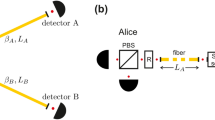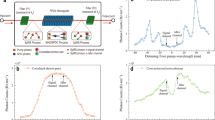Abstract.
Correlated photons produced by spontaneous parametric down-conversion are an essential tool for quantum communication, especially suited for long-distance connections. To have a reasonable count rate after all the losses in the propagation and the filters needed to improve the coherence, it is convenient to increase the intensity of the laser that pumps the non-linear crystal. By doing so, however, the importance of the four-photon component of the down-converted field increases, thus degrading the quality of two-photon interferences. In this paper, we present an easy derivation of this nuisance valid for any form of entanglement generated by down-conversion, followed by a full study of the problem for time-bin entanglement. We find that the visibility of two-photon interferences decreases as V=1-2ρ, where ρ is, in usual situations, the probability per pulse of creating a detectable photon pair. In particular, the decrease of V is independent of the coherence of the four-photon term. Thanks to the fact that ρ can be measured independently of V, the experimental verification of our prediction is provided for two different configuration of filters.
Similar content being viewed by others
References
The Physics of Quantum Information, edited by D. Bouwmeester, A. Ekert, A. Zeilinger (Springer, Berlin, 2000)
W. Tittel, G. Weihs, Quant. Inf. Comp. 2, 3 (2001)
L. Mandel, E. Wolf, Optical Coherence and Quantum Optics (Cambridge University Press, Cambridge, 1995), Chap. 22.4
D.F. Walls, G.J. Milburn, Quantum Optics (Springer Verlag, Berlin, 1994), Chap. 5
C. Simon, D. Bouwmeester, Phys. Rev. Lett. 91, 053601 (2003)
I. Marcikic, H. de Riedmatten, W. Tittel, V. Scarani, N. Gisin, H. Zbinden, Phys. Rev. A 66, 062308 (2002)
H. Weinfurter, M. Żukowski, Phys. Rev. A 64, 010102 (2001)
P.R. Tapster, J.G. Rarity, J. Mod. Opt. 45, 595 (1998)
H. de Riedmatten, V. Scarani, I. Marcikic, A. Acín, W. Tittel, H. Zbinden, N. Gisin, J. Mod. Opt. 51, 1637 (2004)
K. Tsujino, H. Hofmann, S. Takeuchi, K. Sasaki, Phys. Rev. Lett. 92, 153602 (2004)
I. Marcikic, H. de Riedmatten, W. Tittel, H. Zbinden, M. Legré, N. Gisin, preprint arXiv:quant-ph/0404124
W. Tittel, J. Brendel, H. Zbinden, N. Gisin, Phys. Rev. Lett. 84, 4737 (2000)
I. Marcikic, H. de Riedmatten, W. Tittel, H. Zbinden, N. Gisin, Nature 421, 509 (2003); H. de Riedmatten, I. Marcikic, W. Tittel, H. Zbinden, D. Collins, N. Gisin, Phys. Rev. Lett. 92, 047904 (2004)
In Sections [SEE TEXT]–[SEE TEXT] of this paper, where we focus on time-bin entanglement, we call “pulse” each pulse that enters the non-linear crystal; therefore, one qubit is created by two pulses. In reference ivanpra, we had used “pulse” to describe each pulse produced by the pump laser, each such process creating a qubit. So “per pulse” in reference ivanpra is equivalent to “per qubit” here
T.E. Keller, M.H. Rubin, Phys. Rev. A 56, 1534 (1997)
W.P. Grice, I.A. Walmsley, Phys. Rev. A 56, 1627 (1997)
Z.Y. Ou, J.-K. Rhee, L.J. Wang, Phys. Rev. A 60, 593 (1999)
This efficiency factor takes into account the losses on the lines, the quantum efficiency η of the detector, and the amplitude of each monochromatic field component (whose weak ν-dependance has been omitted)
J.D. Franson, Phys. Rev. Lett. 62, 2205 (1989); reviewed in: M.O. Scully, M.S. Zubairy, Quantum Optics (Cambridge Univ. Press, 1997), p. 597
Rigorously, θ=εω. However, since we have extracted the main contribution ωτ, we have εΔω≪π, with Δω the spectral width of the photons (ΔA,B). Consequently, we set \(\theta=\varepsilon \bar{\omega}\) with \(\bar{\omega}\) the central frequency of the photon
Again, we give coincidence rates up to global multiplicative factors. In particular, the multiplicative factor omitted in Section [SEE TEXT] is not the same as the one omitted here: as can be found in Appendix, to compare the rates in the two sections, the rates presented in this section must be multiplied by 1/8. This factor is indeed what one expects, because suppose that Rc is the rate of detection of a pair in the set-up of Section [SEE TEXT]. For the Franson interferometer, in only 1/4 of the cases both photons will arrive in the intermediate time-bin, and there are four possibly detection patterns; but the energy available to create a pair is the energy of two pulses; so indeed the detection rate (averaged over all choices of α+β) in the Franson set-up, supposing the same losses in the lines, is \(R_F=\big(\frac{1}{4}\times \frac{1}{4}\times 2\big)R_c = \frac{1}{8}R_c\)
The data obtained in the early experiment (full squares in Fig. [SEE TEXT]) are more noisy than the new ones (open circles) because the crystal that we used in 2001 was less efficient and because in the meantime we have improved the techniques to stabilize the interferometers
S.A. Podoshvedov, J. Noh, K. Kim, Opt. Commun. 232, 357 (2004)
H.S. Eisenberg, G. Khoury, G. Durkin, C. Simon, D. Bouwmeester, preprint arXiv:quant-ph/0408030
Author information
Authors and Affiliations
Corresponding author
Rights and permissions
About this article
Cite this article
Scarani, V., de Riedmatten, H., Marcikic, I. et al. Four-photon correction in two-photon Bell experiments. Eur. Phys. J. D 32, 129–138 (2005). https://doi.org/10.1140/epjd/e2004-00170-7
Received:
Published:
Issue Date:
DOI: https://doi.org/10.1140/epjd/e2004-00170-7




